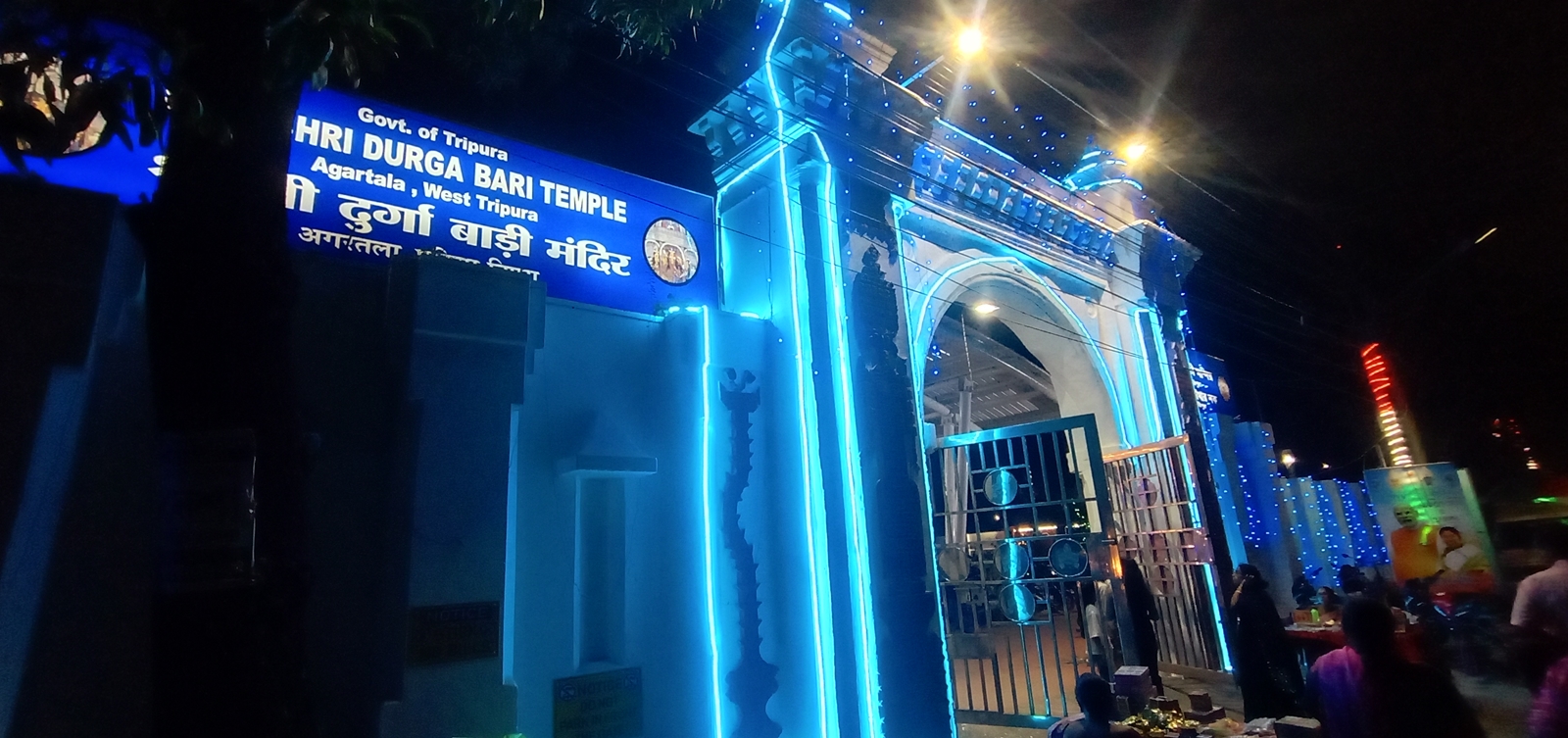Amid theme push, Agartala’s 148-year-old puja at Durgabari continues to be major crowd puller
Durgabari’s head priest, Jayanta Bhattacharya, shared that the temple boasts the only Durga idol of its kind, worshipped initially by his ancestors on behalf of the erstwhile Manikya dynasty.
 Built as a refugee colony for displaced Bengalis after Partition, CR Park has always been known as 'Mini Bengal', a well-preserved cultural island where time seems to stand still. (Express photo by Debraj Deb)
Built as a refugee colony for displaced Bengalis after Partition, CR Park has always been known as 'Mini Bengal', a well-preserved cultural island where time seems to stand still. (Express photo by Debraj Deb)With several clubs organising Durga Puja and showcasing unique themes, the 148-year-old Durga Puja at Agartala’s historic Durgabari continues to be one of the main attractions for devotees. People from different parts of the country and abroad visit this special Durga Puja, where the idol of the goddess has two arms instead of the customary ten, as seen in most other clubs.
Located next to the 123-year-old Ujjayanta Palace—once the royal abode of the Manikya rulers—Durgabari welcomed the Durga idol on Wednesday. History records that Maharani Sulokkhona Devi, wife of Maharaja Krishna Kishore Manikya, who then had his capital at Rangamati (now Udaipur, 50 km south of Agartala), fainted during the ‘Sandhya-arati’ after seeing the ten-armed Durga idol.
According to legend, the queen received a divine commandment in which the goddess assured her that she would appear with only two arms, while the remaining eight arms would be hidden at the back. This would maintain her mythical ‘Doshobhuja’ (ten-armed) form while alleviating the queen’s fear. As a result, the idol was crafted accordingly.
A Unique Idol and Its Custodianship
Durgabari’s head priest, Jayanta Bhattacharya, shared that the temple boasts the only Durga idol of its kind, worshipped initially by his ancestors on behalf of the erstwhile Manikya dynasty. Later, the state government took over the temple, along with Tripurasundari Temple in Udaipur and Chaturdas Devata Bari in Khayerpur, after Tripura’s merger with India on October 15, 1949.
 The Durgabari temple in Agartala. (Express photo by Debraj Deb)
The Durgabari temple in Agartala. (Express photo by Debraj Deb)
“Devi Durga was worshipped in different places where the erstwhile royal family had its capital, including Amarpur, Udaipur, and Old Agartala. The temple was shifted here shortly before Ujjayanta Palace was built, and since then, the goddess has been worshipped here,” Bhattacharya said.
Ujjayanta Palace and Its Historical Significance
‘Maharaja’ Radhakishore Manikya Bahadur built the Ujjayanta Palace in 1901 after the old palace was destroyed by an earthquake. The palace, which housed the state legislative assembly for many years, has been the state museum since 2013. It served as the royal residence until Tripura merged with the Indian Union in 1949.
As per the merger agreement, the West Tripura District Magistrate is the de facto ‘sevayat’ of the Durga Bari Puja rituals, while the DM of Gomati district serves as the ‘sevayat’ of the Tripurasundari Temple. Both temples have historical and mythological significance, dating back over 140 years and 500 years, respectively.
Animal Sacrifice and Tradition
Buffalo sacrifice was once customary at Durgabari but was halted six years ago following a High Court order against ritualistic animal sacrifice. However, a later petition allowed some sacrificial rituals to continue, and while animal sacrifices still occur, the numbers have significantly decreased.
 Devotees at the Durgabari temple in Agartala. (Express photo by Debraj Deb)
Devotees at the Durgabari temple in Agartala. (Express photo by Debraj Deb)
This year, the temple authorities have decided not to accept any sacrifices from devotees. Instead, they will sacrifice five animals, including a buffalo, donated by the government as part of the rituals. One goat will be sacrificed each day of the four-day Puja, along with a bird, which is traditionally sacrificed during the worship of the royal sword.
A Time-Honoured Puja
As tradition dictates, the temple is renovated, cleaned, and painted before each Durga Puja. This year was no exception. The spacious ‘naat-mandir,’ where devotees gather to observe the rituals, has been filled with worshippers on all Puja days so far. According to tradition, the Durgabari idol will be the first to be immersed after Vijaya Dashami at Dashamighat, a popular immersion site on the Howrah River.
Every year, the idols of Durgabari are the first to be immersed at the Dashamighat immersion site, where the state police band plays the national anthem.
Historian Pannalal Roy, an expert on Tripura’s royal history, explained that the Puja bhog (offerings to the deity) at Durgabari includes a unique assortment of fruits, fish, eggs, and alcoholic beverages. These offerings are in line with the rituals of the Shakta order of Hinduism.
Devotees’ Reverence
On Friday, many devotees were seen visiting the Durgabari temple, offering prayers, and bringing their children in hopes of receiving blessings and good health from the deity.
“We visit Durgabari every chance we get. Durgabari is a unique temple, and we wouldn’t miss it for anything,” said Gouri Debbarma, a local devotee.
Sankari Roy, another Agartala resident, echoed the sentiment: “This is a historic spot and a great religious shrine. Many pandals organize Durga Puja every year, but Durgabari is something else.”
According to officials, as many as 2,850 community-organised and over 100 family-organised Durga Pujas are being held across Tripura this year.







